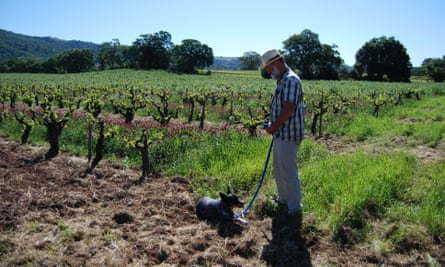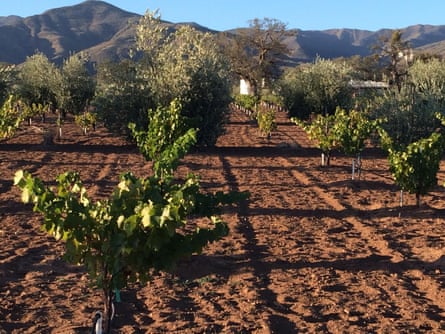There’s something different about Will Bucklin’s grape vines. At first it’s hard to notice, but a drive through northern California’s Sonoma Valley, past waves of green, manicured vineyards, makes it clear. The black ribbon of PVC irrigation pipe that typically threads the vines is curiously absent here – because Will doesn’t water his crops.
Bucklin’s Old Hill Ranch, purchased by his stepfather Otto Teller in 1980, claims to be the oldest-rooted vineyard in the area. Teller fell in love with the vineyard because it was one of the few that still “dry-farmed”. Dry farming is a method that bypasses artificial irrigation, relying instead on seasonal rainfall and working the soil in such a way that it holds on to water for the drier months.
Is it possible to grow healthy grapes without watering them? Actually, if conditions are right, he says, it’s possible to grow even better ones. Less water means smaller, more intensely flavoured grapes with a higher skin-to-fruit ratio. Other crops – tomatoes, potatoes, squash, corn, apples, even marijuana – can be dry-farmed too, with similarly intensified results.
The Mediterranean climate of California’s coastal regions, particularly those to the north, is ideally suited to dry farming. Mornings are cool, afternoons warm, and the rains come every winter. Until the second half of the last century, dry farming was actually the norm here – and still is throughout much of Europe.
“The hardest part about dry farming is actually convincing people it works,” Bucklin says. “But in places like Spain, France and Italy, pretty much everybody dry-farms because it makes better wine.” Irrigation has even been banned in parts of Europe to preserve the quality of certain grape varieties. But in California, where irrigation is now the norm, dry farming has become a forgotten art.

It’s been more than two years since California’s governor, Jerry Brown, declared the drought a state of emergency. How unprecedented this drought is depends on who you ask, and how they measure it. There is broad consensus that it is the worst in centuries; some say in more than a millennium.
Since then, Californians in urban areas have been required to greatly reduce their water use. The mandate to cut back by 25% has largely been met, and at times exceeded, by a population that prides itself on eco-consciousness. Strict restraints on personal water consumption, and drought shaming of those who continue to waste, have attracted headlines.
Yet for agriculture, which accounts for 80% of the state’s human water use, there is no parallel mandate. It’s a reality that has raised eyebrows. That’s not to say the industry isn’t under scrutiny. In 2014, for the first time in its history, the state passed “groundwater” laws that will monitor how farmers use rapidly diminishing subterranean reserves. But there is currently no statewide move to promote alternative methods of irrigation such a dry farming. As Jeanine Jones of the California department of water says: “That’s a choice that growers make. It’s on their side of the issue.”

No dry farmer I met calls it a panacea for the state’s water crisis. But they do lament the loss of an intimate, intuitive style of agriculture that has been overtaken by another: one that privileges yield over quality, and mass management over a farmer’s care and attention.
Dry farming certainly requires a special set of steps. The cultivation of a “dust mulch”, a layer of tilled topsoil that seals in moisture to prevent it evaporating from around the plant’s roots, is one example. Dry-farmed vines take longer to establish, and while they may live longer they also yield less, a proposition unlikely to appeal to everyone. But the argument of quality is one that dry farmers return to in their defense.
“I wouldn’t dry-farm unless it was worth it, if I didn’t think it made better wine,” Bucklin says.
One reason for improved flavor is that dry-farmed vines put down deeper roots; they quite literally go mining for water. “Irrigated vines have roots that live in the top 20 or 30 inches of soil. Dry-farm vines can have root systems as deep as 20 to 30 feet,” Bucklin says.
Deep-root systems produce grapes that are more characteristic of the land they’re grown on. Winemakers call this terroir, and it’s the thing that sets fruit juice apart from the stuff that blows your mind.
“Irrigation will give you good grapes, but they tend not to be unique,” Bucklin says. “They don’t have any soul.”

The Central Valley is largely inhospitable to dry farming. In this industrious backbone of the state, which alone produces a quarter of the nation’s food and 40% of its fruits and nuts, temperatures are too high, the rainfall too low, the farms too large. Yet it’s in the nearby Cuyama Valley where Steve Gliessman and his wife Robbie have established Condor’s Hope, a five-acre farm making dry-farmed wines and olive oil.
Gliessman is one of California’s foremost dry-farming experts and a former professor of agroecology at UC Santa Cruz. Gliessman maintains many crops now dependent on irrigation don’t really need it.
He mentions almonds, the state’s second most valuable crop. Fairly or unfairly, almonds have become shorthand for water inefficiency (the dinner party line goes that it takes a gallon of water to produce one almond in California).
“Almonds are traditionally a dry-farmed crop that does not need irrigation,” Gliessman says. “There are dry-farmed almond orchards in southern Spain that are a couple hundred years old. But when you’ve got 500, a thousand acres, you don’t have much opportunity to be a good steward of your land. You have to make big decisions in a hurry.”
“What we learn from a system like dry farming is that you can farm from limited water,” he continues. “But of course modern farming looks for maximum yield no matter what you have to put in. And in the case of California, that input is water.”
While new groundwater rules may be welcome, Gliessman points out they will take years to come into effect. The state has indeed given itself a generous deadline of 2040 to achieve a fully sustainable groundwater management system, with the possibility to push that back even further.
“Meanwhile, it’s business as usual; drill as deep as you can and get as much out while you can,” he says. “But at what cost? Groundwater is not an unlimited resource. And we have been drawing down on centuries of accumulation. Pretty soon those systems are not going to be able to provide for us.”

I meet farmer Ryan Power on his land in late April, before the start of the growing season. He and childhood friend Adam Davidoff, who run the New Family Farm, were students under Gliessman at Santa Cruz and swear by ditching the PVC pipes.
“I had one journalist who came here and tried our tomatoes, and he nearly shit his britches,” Power laughs. “Seriously, he couldn’t talk for a while. When you think about irrigation as ‘watering the tomato down’, dry farming starts to makes sense to people. Would you rather have a plant that gives you more watery tomatoes, or less, absurdly tasty ones?”
Power currently dry-farms about half his crops, including tomatoes, squash, potatoes and pinto beans. He is especially enthusiastic about the farm’s most recent experiment: dry-farmed quinoa. It’s a grain with huge global demand that requires little water to grow and is not widely farmed in the US.
“Last year we grew over a ton of quinoa per acre without a single drop of water, during the worst drought in 600 years,” he says. “This is a staple crop, not a luxury crop like wine. I’m really excited about the potential.”

Back at Old Hill Ranch, Bucklin swills his glass and takes a sip of his wine. He describes the taste as “almost minty”. It’s true the flavor is both refreshing and deep; lamb and mint sauce springs to mind.
Will’s neighbors, also winemakers, are irrigators. It’s a reality that frustrates him, as it did his stepfather before. “Otto always used to say, ‘these goddamn vineyards are sucking up all the water.’”
Can Bucklin foresee a future in which his way of working swings back into favor? “Human memory is very short, and very adaptable,” he says. “We lived under this dry farming idea for centuries, and it’s only during the last 50 or so years that we’ve changed.
People look at our vines and say ‘how do you survive?’ They think we’re crazy. But it’s really not that complicated. We make plenty of money and plenty of wine, and I think our wine is pretty damn good too. I think we’re doing the right thing.”

Comments (…)
Sign in or create your Guardian account to join the discussion